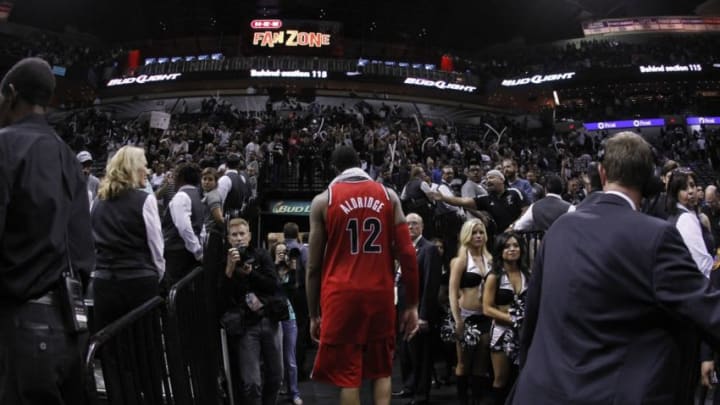
How Aldridge’s obstacles strengthen his case for a jersey retirement
My mind can’t help but wander back to a simpler time: Game Two of the Rockets-Blazers series in 2009 — the first ever postseason victory for the Blazers proclaimed Big Three of the future. Portland got rocked at the Rose Garden in Game One, and early returns suggested a struggle for triumph in Game Two.
And then, it happens.
Blazers coach Nate McMillan throws in his prized 2007 No. 1 draft selection out onto the floor alongside LaMarcus Aldridge and Brandon Roy. Over the next three minutes, the defense was swarming. They were in a zone (not a 2-3 or a 3-2, a mental zone). On offense, the ball sailed across the court unselfishly, with each of the three scoring at least once (see at 26:35). It’s the quick, soothing moments like this that make you understand why the three of them were 50-12 in the 62 games they played together, even as the second-youngest team in the NBA. And just as important, the fans did, too.
So, you can imagine Aldridge’s shock (and everyone else’s), when just a year later, a 21-year old Greg Oden and 24-year-old Brandon Roy are flipped for … 35-year-old Marcus Camby and the likes of Andre Miller and Rudy Fernandez, right?
Times had gotten so bad, McMillan was hesitant to answer the phone, for fear that another season-ending injury was coming.
In a game of numbers, “five” had become the defining number for Rip City.
Seattle Times made headlines for that Jan. 2011 article, noting that the “Battered ‘Frail Blazers’ had somehow ran off five straight wins, even with five rotational players on injured reserve to the same injury: arthroscopic knee surgery. A crumbled core could’ve shaken Aldridge, and he even said as such:
"“Every time you suit up and you hear a key guy’s not playing, it’s like, ‘Man, what are we going to do now?’” – LaMarcus Aldridge"
But Aldridge kept plowing along — with a pair of top-three finishes in Most Valuable Player award voting as his testament — knowing that if Portland could rely on nothing else, they could count on his 22 and 9.
Info-video (📈🎥) of LaMarcus Aldridge's (🚂) 2014-15 season (🏀)https://t.co/8IpeoTMmmj
— Portland Trail Blazers (@trailblazers) May 19, 2015
You’d be hard-pressed to find a rockier, more injury-plagued five-season stretch than Portland from 2008-09 to 2012-13. To show how much we should appreciate what LaMarcus Aldridge did do, series wins be darned, let’s put a number to that. Over that five-season span, he was the only Blazer to log 10,000 total minutes played. And that’s not some high hurdle. That’s just 24 minutes per game over an 82-game stretch.
Perhaps more impressive than that, Aldridge’s on-court, off-court never swayed; whether he shared the floor with the likes of Nicolas Batum and Wesley Matthews or Nolan Smith and Luke Babbitt, the Blazers produced. His +4.2 per 100 possessions was nearly a top-20 mark in the Association.
Pressure comes in many shapes and sizes. And whether he saw it as such, here was LaMarcus Aldridge’s pressure. No one could’ve come at him or his career recklessly if he missed games to injury, or missed the postseason time-after-time, given the wreckage around him. But if he had, we can estimate the results — the Blazers won 15 of 55 games without Aldridge (a just-as-horrendous 23-51 if you add his rookie season in 2006-07).
The awkwardness of watching him leaving for warmer summers in San Antonio isn’t something that can be easily forgotten. But over time, we can learn not to hold that against him, and here’s why.
